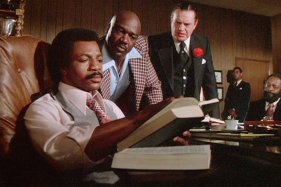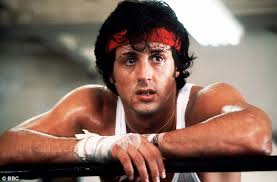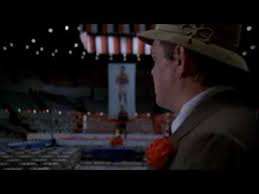Growing up in a small, dying mill town in western Pennsylvania didn’t afford us many luxuries, so family night at the movies was a real treat. My dad was a steelworker, and a rather eclectic movie fan. He cheered for John Wayne in True Grit, and grieved with Sophia Loren in Two Women. He loved discussing the movies we saw and prodding my sisters and me for our opinions.
Throughout the 60s, the boom years for steel towns throughout the region, there were lots of movies aimed at the family audience. But by the 1970s, movies were changing. Swear words, nudity, and violence were things my devout Catholic parents were not going to pay for us to see. Especially with layoffs looming and money becoming tight. Paying for five people to see a movie meant not paying for something else.
One night my mother suggested we go to see Cabaret. It was a musical, so I’m sure mom thought it must be wholesome family entertainment. We piled in the car and went off to the movie theater at the mall. I remember sensing my dad’s uneasiness early on in the movie. My sisters and I grew even more uncomfortable with the decadence and sexuality, eventually slinking down in our seats. My mom was silently praying for Julie Andrews and singing nuns to somehow show up in the Kit Kat Club in Berlin.
The ride home was stony silence. My dad shooting “what were you thinking” glances at my mom in the front seat, my sisters and I trying to figure out what we had just seen in the back. I had nightmares of Joel Grey’s false eyelashes for months.
It would be years before we saw another movie all together.
One day, at the dinner table, my dad commented that he’d read about a little movie that sounded interesting. “It’s about a boxer,” he explained. “It’s called Rocky and I think I want to see it.” Apparently Newsweek magazine had run a blurb about its word of mouth momentum.
The movie hadn’t yet caught on nationally so it wasn’t playing at the big theater at the mall. Instead, one frigid night, we drove to a deserted downtown to see it. The small theater was not quite half full. I was wearing my fake rabbit fur winter jacket with my black and gold Steeler pom pom hat. I remember being annoyed that my mom wouldn’t buy me Milk Duds or Ju Ju Bees because they’d get stuck in my braces.
After the Cabaret disaster, I was especially tense about whether or not my dad would sit through the movie, let alone like it. I spent the first part of the movie watching it out of one eye and my dad out of the other. I was monitoring his reactions, waiting for the first f-bomb or naked breast that would cause him to pull us out of our seats and take us home in disgust. He’d not only settled in; he was watching intently.
I relaxed and turned my full attention to the screen. Rocky was sitting in the fight promoter’s office, with people urging him to accept Apollo Creed’s unbelievable offer for an unknown boxer to fight the champ. The camera stayed on Rocky’s face. I felt how he was both afraid to take it and afraid not to.
I never looked away from the screen again.
 My favorite scene in the film. Perhaps the last time we saw Stallone underplay a scene until Creed.
My favorite scene in the film. Perhaps the last time we saw Stallone underplay a scene until Creed.
Rocky is not a great film. It is a very, very good one. There’s a reason it became a box office smash and a modern classic. It is hands down the most memorable and exciting movie going experience of my life.
The story is simple. A down on his luck, no-name boxer in Philadelphia is given the chance of a lifetime to fight the flamboyant World Heavyweight Champion. At the same time he is starting a tentative, tender romance with the introverted sister of his best friend. He discovers his dignity and realizes he finally has something to fight for.
When the film came out, many sophisticated critics ridiculed it as a derivative fairy tale, some sort of rehash of a lesser Frank Capra movie. Sylvester Stallone, who starred as Rocky, wrote the screenplay and took the brunt of the criticism. They had a point. It was 1976, and compared to the cynicism of Network, the paranoia of All the President’s Men and the nihilism of Taxi Driver, this little movie seemed like a naïve fantasy.
But Rocky is full of anger, rage and sadness. The story’s innate sentimentality is grounded in drab, raw realness. Nothing is “pretty” in Rocky. The movie looks lived in. Characters wear clothes, not costumes. People yell at each other. A lot.
 The street where Rocky lives. He may have been from Philadelphia, but his story echoed with working class folks in the western part of Pennsylvania too.
The street where Rocky lives. He may have been from Philadelphia, but his story echoed with working class folks in the western part of Pennsylvania too.
Because he was an unknown, and his script had made the rounds in Hollywood for a while, Stallone had to fight to get Rocky made and fight to star in it. The trade-off was the studio insisted on a low budget and quick filming schedule. The entire movie was shot in 28 days.
Perhaps the two best things that happened to the movie were the budget restrictions and the studio bringing in a journeyman director, John G. Avildsen. One reviewer called Avildsen “lazy.” He wasn’t. He simply got out of the way of a great story and cast the movie with actors who were either unknown or barely known to audiences. It’s telling that the biggest “name” in the cast was Burgess Meredith. (“Well he’s always good in movies, isn’t he? He wouldn’t be in a dirty movie, would he?” my mom sweetly asked my dad on the way to the theater.)
There is a plainness and lack of self-consciousness in the performances that made me feel I wasn’t watching actors, I was somehow eavesdropping on real people at the most dramatic moment of their lives. Stallone is undeniably appealing. He wasn’t handsome, and in truth, he looks meaty, lumpy and pale. You can believe he is a third-rate fighter. Rocky was his creation, and he brings genuine humility, humor and heart to the role. One wonders how Avildsen was able to reign in the self-reverential preening that Stallone displayed starting with the first sequel and perfected over his 40 year career.
 The Rocky who won our hearts, before faux tan, hair mousse and plastic surgery turned him into robotic imitation.
The Rocky who won our hearts, before faux tan, hair mousse and plastic surgery turned him into robotic imitation.
Rocky’s love interest, Adrian, is the repressed, frightened, old maid sister of his best friend, Pauly. Talia Shire, who was cast after Carrie Snodgrass turned the part down, brought both sensitivity and ferociousness to a woman who had never been valued in her life. Her bitter confrontation with Pauly is achingly painful to watch. Even her “makeover” is believable. It looks like a prettier, younger cousin took her to the beauty counter at Wannamaker’s in downtown Philly and then bought her some new clothes. The pantsuit she wears at the end of the film doesn’t even fit her properly. Similar to Bette Davis’ brilliant transformation in Now, Voyager, Shire’s Adrian blooms from within.

Talia Shire was one of the last principals cast. Susan Sarandon was screen tested but deemed “too attractive.”
Burt Young, as her loser brother Pauly, is used mainly for comic relief, until jealousy of his friend’s luck begins eating him alive. He knows he may soon be abandoned by both Rocky and Adrian, and erupts from years of frustration, loneliness and hurt.

Burt Young’s Pauly ruins the holiday. I can still hear my mother muttering “poor Pauly” for days after the movie every time she passed our Christmas tree.
A former professional football player turned actor, Carl Weathers, plays the champion Apollo Creed, who Stallone obviously based on Muhammed Ali. Weathers’ handsomeness, athleticism and crisp diction make him not only Rocky’s opponent, but his better in every way – he looks better, fights better and sounds better. Rocky knows he’s outclassed not just in the ring, but in life too. Creed could have easily been a “villain” of sorts, but Stallone and Weathers make Apollo smart, savvy and completely in control of the “spin” surrounding the fight.

Apollo Creed looks for a small time fighter to face in an exhibition bout. He finds “The Italian Stallion.” Real life boxer Ken Norton declined the Apollo role.
If there is any false note in the film, it’s the veteran Meredith as Rocky’s trainer, Mickey. Maybe it was because he was the biggest “name” in the film that the familiarity makes him seem less “authentic” compared to the revelatory turns by Stallone, Shire, Young and Weathers. When he first appeared in the film, my sister was waiting to hear him do the Penguin laugh from Batman. It’s the one performance in the film that, well, feels like a performance.

The producers wanted Lee Strasberg for the role of Mickey but couldn’t meet his asking price.
Avildsen cast the supporting roles with meat and potato character actors who looked like he grabbed them off the street in Philadelphia. He generously gives Thayer David (the fight promoter), Tony Burton (Apollo’s manager) and Joe Spinell (Rocky’s small time gangster boss) moments that do much to create the gritty, small, ordinary world where Rocky knows his place. It’s a harsh, grimy place, as are the people who populate it.

Spinell had an asthma attack shooting his first scene, and used his inhaler. Avildsen used that take in the final cut.
Rocky was just the second film to use a Steadicam, which enabled the breathtaking shot of Rocky mounting the steps of the Philadelphia Museum of Art as well as the climatic fight scene. For the famous training sequence, much of the footage, including Rocky’s run through the street market and on the quay by the boat, were shot on the fly – Avildsen and crew couldn’t afford to pay for the film permits. Instead, they drove around in a van filming Stallone in improvised locations. That type of montage is now such  a staple in movies, it’s hard to remember how fresh it was in Rocky. So many post-Rocky “underdog” films have copied it (including Avildsen’s own Karate Kid) that you can’t believe it was never a cliché.
a staple in movies, it’s hard to remember how fresh it was in Rocky. So many post-Rocky “underdog” films have copied it (including Avildsen’s own Karate Kid) that you can’t believe it was never a cliché.
The inventor of the Steadicam first tested it with his girlfriend running up the steps of the Philadelphia Museum of Art. Avildsen saw the footage and it inspired the movie’s most famous image.
Many film critics grumbled when Avildsen won the Oscar over other more well-regarded directors. They blamed the win on the out-of-touch Academy of Motion Picture Arts and Sciences (sound familiar?) The fact is, though, that the hipper Directors Guild gave their prize to Avildsen too.

Avildsen collects his Oscar. He beat Ingmar Bergman, Sidney Lumet, Alan J. Pakula and Lina Wertmuller.
Whenever I talk movies with fellow movie buffs, I see them roll their eyes when I bring up Rocky. Their perspective of the original film is skewed by its association with the sequels that followed. If only the story of Rocky ended when the film ended, with Rocky and Adrian frozen in a triumphant embrace. Instead, Stallone, the producers, and the studio cashed in and pimped the characters out. The newly trim, bronzed and blow-dried Stallone made Rocky into a cartoon, and threw the supporting characters to the side. The sequels were overacted, overproduced, overblown, yet strangely underpopulated. Rocky now lived in a vacuum. He was the only character that mattered. And don’t even get me started on the red sweat band in Rocky II. It’s more frightening than Joel Grey’s false eyelashes.

Just all kinds of wrong.
It’s a shame that the sequels exploited and cheapened what made the original so stunning, and such a visceral experience 40 years ago.
It was deep in the post-Vietnam, post-Watergate, Jimmy Carter administration malaise. We were worn down by inflation and oil embargos. In small towns like mine, an entire industry was collapsing. Steel mills, coal mines and manufacturing plants were lumbering dinosaurs on their way to extinction. Anti-heroes and emancipated women were the darlings at the box office. Hard-working, decent guys like my dad were just looking for a break. They weren’t seeing who they were – or who they wanted to be – on the screen.

The night before the fight, Rocky sees that a banner has the color of his trunks wrong. (An actual mistake made by the props department.)

“Does it matter?” says the fight promoter, in a line that Stallone wrote on the spot.
Back to my parents and my sisters and I in a small theater on a freezing western Pennsylvania night. My dad and mom likely entered the theater that night with lots on their minds – car payments, mortgage, saving to send three girls to college, the nasty chronic cough my dad had from smoking too many cigarettes. They were probably prepared to have another movie disappoint them, and embarrass their daughters.
With Rocky clutching Adrian in freeze-frame (it was the 70s) and the strains of Bill Conti’s iconic score playing over the final credits, someone in the audience began clapping. Soon everyone was on their feet applauding, which then turned into cheering. I heard the man behind me tell his date “I feel like I could lift this theater on my shoulders right now!” I did too. More importantly so did my dad. He was literally out of breath and invigorated when the movie ended.
Walking to the car, my family was excitedly replaying scenes and dialogue. They were already planning on telling others at work, at church and at school to be sure to see Rocky. I wasn’t. In some strange way, I didn’t want Rocky to be a hit. I wanted it to remain something special that had happened just to us. No one will ever know or love these people like we did, I thought. Somehow, keeping the movie a secret meant being able to hold onto the joy forever. One of my sisters suggested that we come back the next night and see it again. For a moment my dad considered it. I’m glad we didn’t. While I’ve enjoyed seeing the movie again over the years, nothing will ever top that first time.
As we were driving home, my mom, sisters and I were arguing about whether or not Rocky had actually won the fight. “What difference does it make?” my dad said from the front seat. “He was a winner either way. All I know is when he ran up those stairs, I was right there with him. What a movie!”
Yo, dad, you were right. Rocky was a winner. And a knockout.

